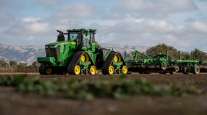Staff Reporter
Agriculture Supply Chain Upended by Virus, Expert Says

[Ensure you have all the info you need in these unprecedented times. Subscribe now.]
Disruptions to the food supply chain brought on by the coronavirus pandemic extend to farmers and their products, according to Andrew Novakovic, a professor of agricultural economics at Cornell University.
Novakovic, who participated in a webinar hosted by the Eno Center for Transportation on May 21, pointed out that the virus has interrupted demand and caused many food services to shut down. While stay-at-home orders have prompted many people to seek out grocery stores, these restrictions also have triggered steep drops in sales at bars and restaurants.
Many farmers have had to allow their products to rot in the field. Slaughterhouses have started to cull their herds of hogs. Dairy farmers have had to dump milk. Novakovic said that milk dumping must be done in an environmentally safe manner and still requires tank truck services; farmers can’t release valves of milk anywhere on their property.

Novakovic
“You have to do this in a responsible way and still use trucks,”said Novakovic, who specializes in agricultural policy and dairy product food systems. “On the supply side, [one] big interruption is not having a customer.”
Novakovic said that end users such as food manufacturers, retailers and representatives of the food service industry often have a variety of transportation solutions. He noted that cost and quality are factors that must be considered when purchasing transportation services, particularly in the case of food and agriculture. Quality is especially important in terms of timeliness, safety of the product and care and handling of a product. “Certainly cheaper is always a pleasant outcome, but the quality of the service is probably even more important,” Novakovic said.
Transportation costs vary by product, Novakovic said. Food products’ physical characteristics can range from dense, dry and highly storable to bulky, wet and highly perishable. These factors help determine transportation needs, such as refrigerated vans, tank trucks or general freight equipment.
Novakovic identified “fragile” items that have particular safety challenges as eggs, poultry, red meats and fats and oils, which can be temperature-sensitive. Fresh vegetables also can present challenges.
“Fresh vegetables are fragile [and] subject to a certain degree of contamination, but [there’s] also more of an issue about damage,” Novakovic said.
Milk, an area of Novakovic’s academic focus, requires the use of specialized crates, to a large degree. Milk is generally picked up from farms once a day in highly specialized tankers. The milk is then taken to a fluid milk processor, which transforms it into the product that people are used to consuming. The finished product is then transported to a distribution center or store.
Wisconsin and New York, two of the country’s leading dairy states, require special certifications for milk haulers.
“In many cases, there are regulatory requirements imposed on agriculture and food handlers that go beyond what you would see in general freight,” Novakovic said.
Want more news? Listen to today's daily briefing:




